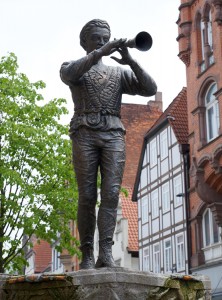Mythic Monday: Pay the Piper
October 16, 2017
The Pied Piper of Hamelin is a legendary character in German folklore. According to a folk story, in 1284 the German town of Hamelin (Hameln in German) was suffering from a plague of rats. One day, a mysterious stranger dressed in a pied (many-colored) suit walked into Hamelin and offered to rid the town of the pests for a sum of money. After the mayor agreed, the man drew out a pipe and walked along the streets playing a haunting tune. All the rats came tumbling out of the houses and followed the Piper to the Weser River, where they drowned. When the Piper—known in German as der Rattenfänger (the rat catcher)—came to collect his fee, the mayor refused to pay him. The Piper swore vengeance. Once more he walked along the streets playing his strange melody. This time, the town’s children ran from their homes and followed him to a cave in nearby Koppen Hill. The cave closed upon them, and the children were never seen again.
The legend seems to be based at least in part on fact. Old writings on the walls of several houses in Hamelin say that on July 26, 1284, a Piper led 130 children out of town and that they were lost in Koppen Hill. Some believe that the Piper was an agent of the Bishop of Olmutz, who in the late 1200′s took many Hamelin children to Moravia, where they were resettled. Others claim robbers kidnapped the children. It is also possible that the legend came from the disastrous Children’s Crusade of 1212. The story of the Piper was popularized in modern times by a famous poem by the English poet Robert Browning.
The story of the Pied Piper has made the picturesque Hameln a major tourist attraction. Along the cobblestone streets of the Pied Piper Trail, every few feet there is an imprinted white rat in a bronze plate pointing the way to the main attractions of the town. The Pied Piper House (1602) is one of the town’s largest and prettiest buildings. Several times a day, a clockwork display of figures in the Wedding House (1610-1617) appears in a window and acts out the Pied Piper story. Chimes in the building play what is said to be the Piper’s haunting melody. Every Sunday from mid-May to mid-September about 80 actors in historical costumes recreate the story of how the children of the town went missing.



